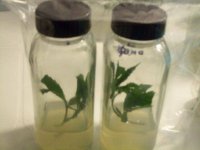BobbyIronsights
Member
I like to read. and what I'm reading lately is on plant tissue culture, specifically
Plant Tissue Culture-Theory and Practice (Studies in Plant Science) By Dr.s Bhojwani and Razdan,
and
Plant Tissue Culture, Third Edition - Techniques and Experiments by Dr. Roberta H. Smith
Really exciting reading both, and the english of the two university of Dehli's professors is faultless, at least in the book.
I'm wheelchair bound, but while researching propagation techniques it occurred to me that I could dust off the old microscope and amuse myself with a part of the cannabis hobby that plays to my strengths (a pure sciences background) and not my weaknesses (physical limitations.).
I mean, I'm a chemist (bachelors) by training, but I still have a chemical supply house account and I know where to get autoclaves and other used scientific equipment.
I was particularly fascinated by "rescue" culture, where the embryo is freed from non-viable seed (because of extreme age or immaturity) and cultured into a mature plant via agar or broth based media.
I've been thinking that it may not be out of the realm of possibility to setup a small botany lab, and fiddle around a bit. For fun, and to stave off boredom.
Is anyone else here practicing cell culture? Are there other textbooks I shouldn't miss out on reading?
Thanks for your time.
Bob
Plant Tissue Culture-Theory and Practice (Studies in Plant Science) By Dr.s Bhojwani and Razdan,
and
Plant Tissue Culture, Third Edition - Techniques and Experiments by Dr. Roberta H. Smith
Really exciting reading both, and the english of the two university of Dehli's professors is faultless, at least in the book.
I'm wheelchair bound, but while researching propagation techniques it occurred to me that I could dust off the old microscope and amuse myself with a part of the cannabis hobby that plays to my strengths (a pure sciences background) and not my weaknesses (physical limitations.).
I mean, I'm a chemist (bachelors) by training, but I still have a chemical supply house account and I know where to get autoclaves and other used scientific equipment.
I was particularly fascinated by "rescue" culture, where the embryo is freed from non-viable seed (because of extreme age or immaturity) and cultured into a mature plant via agar or broth based media.
I've been thinking that it may not be out of the realm of possibility to setup a small botany lab, and fiddle around a bit. For fun, and to stave off boredom.
Is anyone else here practicing cell culture? Are there other textbooks I shouldn't miss out on reading?
Thanks for your time.
Bob




